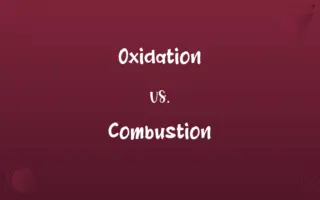SATA vs. PATA: Know the Difference

By Hifza Nasir & Shumaila Saeed || Published on March 8, 2024
SATA offers faster data transfer and slimmer cables than PATA, which uses wider connectors and is less efficient.

Key Differences
Serial ATA (SATA) and Parallel ATA (PATA), also known as IDE, are two interfaces used for connecting storage devices like hard drives and optical drives to a computer's motherboard. SATA, the newer standard, provides several advantages over PATA, including faster data transfer rates, thinner cables for better airflow within the case, and support for hot swapping.
Hifza Nasir
Mar 08, 2024
PATA, once the standard for disk drives, utilizes a wider, 40 or 80-wire ribbon cable and supports a maximum cable length of 18 inches. This limitation can affect the organization and cooling of the computer's internal components. SATA cables are narrower, only 7 wires, and can be up to 1 meter long, offering more flexibility in system design.
Shumaila Saeed
Mar 08, 2024
Data transfer rates significantly differ between the two, with SATA offering speeds from 1.5 Gb/s to 6 Gb/s in its various versions, whereas PATA's maximum transfer rate caps at 133 MB/s. This makes SATA more suitable for applications requiring high data throughput, such as gaming and video editing.
Hifza Nasir
Mar 08, 2024
PATA supports two devices per channel (master and slave configuration), which can complicate device configuration and lead to potential bottlenecks. SATA simplifies this by allowing one device per cable, eliminating the need for master/slave settings and improving overall data integrity and performance.
Dua Fatima
Mar 08, 2024
Despite SATA's dominance, PATA still finds use in older systems and certain applications where compatibility with legacy technology is required. However, SATA's advantages make it the preferred choice for new builds and upgrades.
Shumaila Saeed
Mar 08, 2024
ADVERTISEMENT
Comparison Chart
ADVERTISEMENT
SATA and PATA Definitions
SATA
One device per cable.
Each SATA device connects directly to the motherboard without sharing, reducing data bottlenecks.
Hifza Nasir
Feb 26, 2024
PATA
Legacy interface.
PATA was the standard for older hard drives and optical drives, compatible with vintage systems.
Shumaila Saeed
Feb 26, 2024
SATA
Supports hot swapping.
SATA allows for the removal and replacement of drives without shutting down the system.
Dua Fatima
Feb 26, 2024
PATA
Shorter cable length.
The maximum cable length for PATA is 18 inches, limiting placement options within the case.
Shumaila Saeed
Feb 26, 2024
SATA
Longer cable length.
SATA cables can be up to 1 meter long, offering more flexibility in system design.
Hifza Nasir
Feb 26, 2024
ADVERTISEMENT
PATA
Master/slave configuration.
PATA supports two devices on one cable, requiring jumper settings for master and slave roles.
Shumaila Saeed
Feb 26, 2024
SATA
Slimmer cables.
SATA's narrow cables improve airflow and cable management inside computer cases.
Hifza Nasir
Feb 26, 2024
PATA
No hot swapping.
PATA does not support hot swapping; systems must be powered down to change drives.
Hifza Nasir
Feb 26, 2024
SATA
Faster data transfer.
SATA III interfaces can transfer data at speeds up to 6 Gb/s, enhancing performance for high-speed drives.
Shumaila Saeed
Feb 26, 2024
PATA
Wider cables.
The wide ribbon cables of PATA can hinder airflow and cable management in cases.
Hifza Nasir
Feb 26, 2024
Repeatedly Asked Queries
What is SATA?
SATA (Serial ATA) is a computer bus interface for connecting storage devices, offering faster data transfers and more efficient cabling than its predecessor, PATA.
Shumaila Saeed
Mar 08, 2024
How do cable differences between SATA and PATA affect system design?
SATA's thinner cables improve airflow and cable management within a computer case, while PATA's wider cables can obstruct airflow and complicate cable management.
Hifza Nasir
Mar 08, 2024
What is hot swapping, and which standard supports it?
Hot swapping is the ability to remove and replace components without shutting down the system. SATA supports hot swapping, whereas PATA does not.
Dua Fatima
Mar 08, 2024
How does the data transfer rate of SATA compare to PATA?
SATA offers significantly higher data transfer rates, ranging from 1.5 Gb/s to 6 Gb/s, compared to PATA's maximum of 133 MB/s.
Shumaila Saeed
Mar 08, 2024
Why is SATA preferred over PATA?
SATA is preferred due to its higher data transfer rates, longer and more flexible cabling, and support for hot swapping, making it more suitable for modern computing needs.
Shumaila Saeed
Mar 08, 2024
How does the master/slave configuration in PATA work?
In PATA, two devices can share one cable, with one set as the master and the other as the slave, using jumper settings to define their roles.
Shumaila Saeed
Mar 08, 2024
Why does SATA eliminate the master/slave configuration found in PATA?
SATA allows one device per cable, eliminating the need for master/slave configurations and improving ease of use and data throughput.
Hifza Nasir
Mar 08, 2024
What applications benefit most from SATA's faster data transfer rates?
Applications requiring high data throughput, such as gaming, video editing, and high-performance computing, benefit most from SATA's faster rates.
Hifza Nasir
Mar 08, 2024
What is PATA?
PATA (Parallel ATA), also known as IDE, is an older interface standard used for connecting storage devices, characterized by wider cables and slower data transfer rates.
Hifza Nasir
Mar 08, 2024
Can SATA and PATA be used interchangeably?
SATA and PATA cannot be used interchangeably due to different connectors and signaling protocols, but adapters exist to connect PATA drives to SATA motherboards and vice versa.
Hifza Nasir
Mar 08, 2024
What is the maximum cable length for SATA and PATA?
SATA supports cable lengths up to 1 meter, providing greater flexibility in system design, while PATA cables are limited to 18 inches.
Shumaila Saeed
Mar 08, 2024
Can I connect a SATA drive to a PATA-only motherboard?
Yes, with a PATA-to-SATA adapter, you can connect a SATA drive to a PATA-only motherboard, though this may limit the drive's performance.
Hifza Nasir
Mar 08, 2024
Is PATA still used today?
While largely obsolete in new systems, PATA is still used in some legacy systems and applications where old hardware compatibility is necessary.
Hifza Nasir
Mar 08, 2024
What advancements in SATA have been made to improve performance?
Advancements in SATA include increased data transfer rates with each revision (e.g., SATA I, II, III), improved cabling, and features like native command queuing (NCQ) to enhance performance.
Shumaila Saeed
Mar 08, 2024
Are there any advantages to using PATA over SATA?
The main advantage of PATA over SATA is compatibility with older hardware and systems that require a PATA interface.
Hifza Nasir
Mar 08, 2024
Share this page
Link for your blog / website
HTML
Link to share via messenger
About Author
Written by
Hifza NasirCo-written by
Shumaila SaeedShumaila Saeed, an expert content creator with 6 years of experience, specializes in distilling complex topics into easily digestible comparisons, shining a light on the nuances that both inform and educate readers with clarity and accuracy.








































































